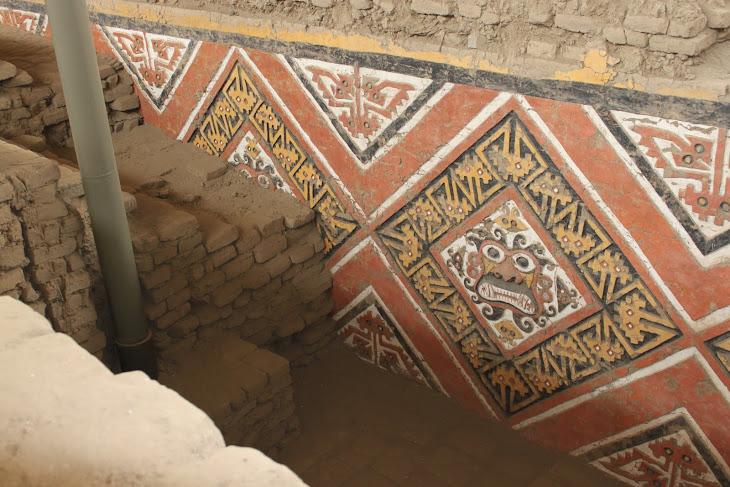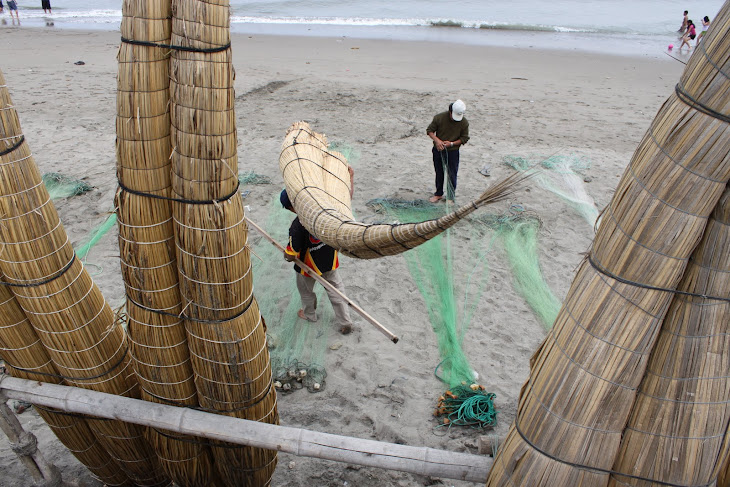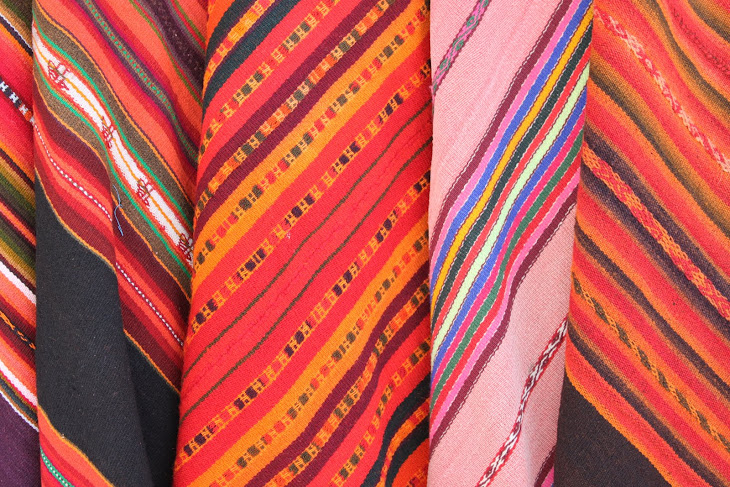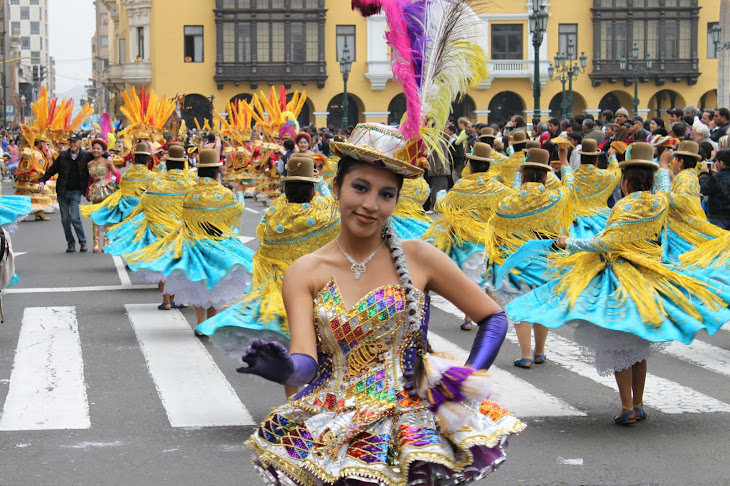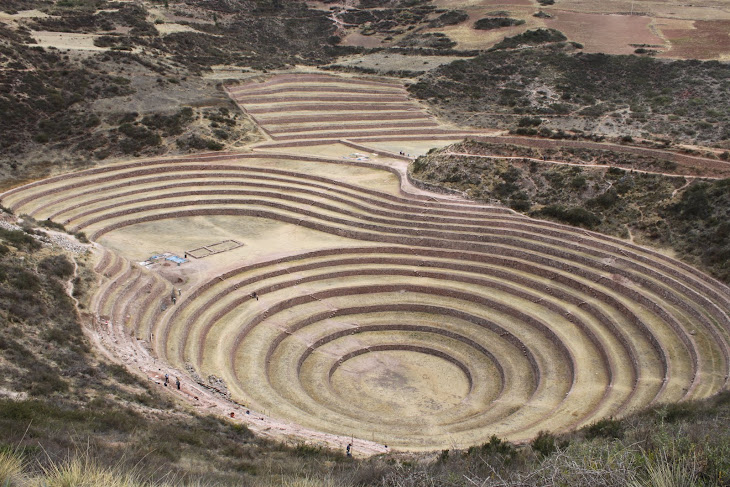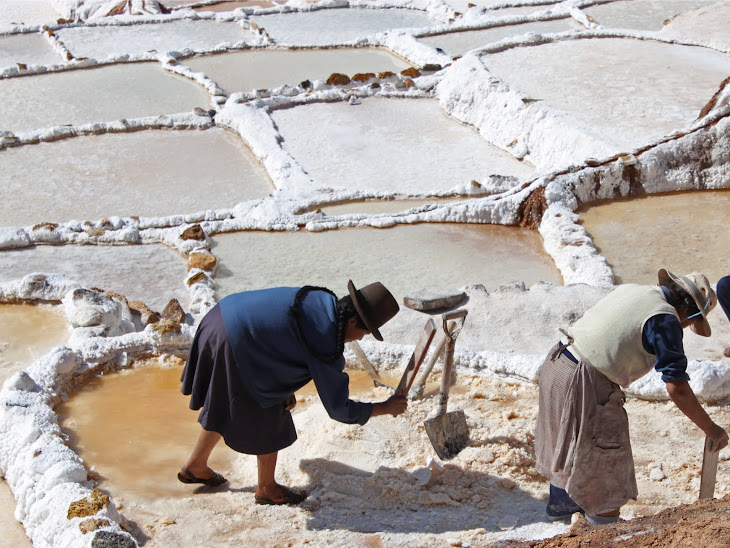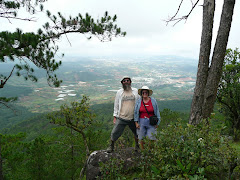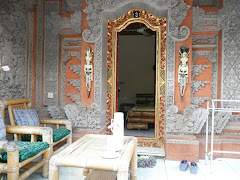Thursday, December 24, 2009
Our Own Oz Odyssey
We've been bouncing around Australia for a few weeks, with no plans to do the Big Three touristy bits - Ayers Rock/Uluru (too far), the Great Barrier Reef (Karen can't swim) or climbing Sydney Bridge (too costly). Instead we visited the Blue Mountains outside Sydney, the Adelaide Hills and Tasmania, which allowed us to focus on hiking and wine-tasting, two of our favourite activities. Australia has not disappointed us on those counts, with lots of information about shorter hikes (4 hours max) and wine regions we weren't previously aware of, both of which we have found in Tasmania. Even though we never saw the mountain at Cradle Mountain, and it rained (again) most of the time, we enjoyed the hike around Dove Lake in the drizzle and took lots of macro shots of flowers whose names we have no idea of. That's another thing about Australia: the flora and fauna are completely different. We feel like idiots. We had a fit of giggles the first time a wallaby hopped across the road in front of us - a bit of hysterics over not creating a roadkill mess with our first wildlife encounter. In Adelaide, we had the great fortune to be able to rest at the home of a couple we had met in New Zealand. Thanks Angela and Simon. They had offered their trailer and we had meant to take them up on it for just a few days, but Karen caught a cold and the timing was perfect for her to rest up with short forays into the Adelaide Hills to visit an animal sanctuary and a few wineries. The sanctuary protects native wildlife from imported predators and we hand-fed some eastern grey kangaroos. My, their muzzles are soft. We also spotted a few koalas and heard our favourite quote (from the night-walk guide): "Please don't step on the bandicoots" as the cute little buggers ran around our feet. Tasmania is a small place with oddly long stretches of driving. They warn you about that, but it's hard to believe until you actually drive across the island in one day. It was something like 300 kilometres in 8 hours, with a few stops, obviously. The scenery is so sprawling it's hard to fit it in a photo and outposts of civilization are so small you can stroll through whole towns in less than an hour. Bob splurged in Bridport after we discovered a golf course rated 7th in the world among public access courses. He started early enough in the day that there were wallabies munching on the first five fairways and he didn't see another golfer until the eighth hole. Karen spent the same morning hiking along the coast, shooting photos of the beach boulders covered in orange lichen and losing her way on the poorly marked trail. We are staying through Christmas on a working farm overlooking the Tasman Sea a couple hours north of Hobart. Yesterday we spent a whole day in Freycinet National Park, hiking over a steep mountain saddle to the iconic Wineglass Bay beach. We bought enough groceries and wine to get us through the holidays, which is good because then we don't have to drive that winding gravel road in the rain. There are hikes near here, books to read and wine to drink. Not Christmas as we know it, but not a bad substitute.
Monday, December 7, 2009
New Zealand - the lost bits
We were a little rushed on the last blog post . . . prepaid Internet connections always have a very annoying timer ticking away while you are busy trying to be fun to read. So, in our rush, we missed a few bits about New Zealand, like the wildlife. Which they don't have any of. See, when the Europeans arrived, New Zealand had no land animals other than a few types of bats. Sure there were sea lions and otters, but no raccoons, porcupines, skunks or bears, the kinds of things we worry about when we are camping in Canada. It was really jarring for us to watch Kiwi campers leaving their food about and not packing everything up at night to keep the animals out. I explained to some of them (all google-eyed) that when we camp for real, we don't wear the same clothes to bed that we wear when we are cooking. And you need a long rope to tie your food bag up in a tree. But New Zealand does have a wide variety of bird life, so all of our walks involved a lot of pausing to listen to bird songs . . . bird-watching is such a pain, you hardly ever see the smaller ones with the most exciting bird calls. But our last night of rural camping remains a highlight because of a single bellbird. You see, these birds are supposed to have a remarkable call like a bell, but we could never be sure if we were hearing one. Until we camped in a remote Department of Conservation site off a gravel road near Fairlee. It was a rainy, cold night and our van Syd was the only vehicle there. While we were cooking up pasta under a big sheltering tree, we heard the sound of a blacksmith's anvil. Now this was weird because we were nowhere near anyone, much less a blacksmith, but we supposed it might be from a nearby farm. But that didn't seem right, this was a single repeated CLINK like a hammer hitting an anvil, but not from very far away. We walked towards the sound and it seemed to be quite close overhead. Then we heard slight variations in the CLINK sound and it dawned on us . . . now THAT'S a bellbird. And there were no other campers to tell. One other item . . . dining. Dining was an odd affair for us in New Zealand. We were kind of camping, so there was a lot of campfood . . . dried pasta mixes with tuna or veggies added after the cooking, soup mixes (ditto), cheese and pickle sandwiches ("pickle" is more like a chutney; we bought rhubarb raisin pickle and tomato clove pickle from a nice old Kiwi couple at Jack's Blowhole), peanut butter and jelly sandwiches, muesli breakfasts and occasionally some sausages or meat that had to be bought and eaten in the same day because Syd the van's plastic food cooler was so small. (I really should post a picture of Syd.) But every now and then we ate out, and since most of our dining on the road was low-end, we splurged at the restaurants. In particular, in Kinloch, we stayed at a Department of Conservation campsite for $14 a night but ate at a lodge next door where our bill for the night was $188. That's Kiwi dollars, but still. Spectacular food and drink in a superb setting. If it wasn't for the rain . . .
Friday, December 4, 2009
NZ and a wee bit of AU
Everything in New Zealand is an acronym, thus the title of this post. We spent 20 days touring the South Island in the rain in a van. We kept saying, over and over, "I'm glad we're not in a tent." After so long in the van, however, things were awfully cramped, our belongings were a mess and everything was a bit smelly. Let's not even talk about the claustrophobia that Bob suffered with his head wedged into a back corner and his feet shoved between the front seats. Karen had a cold the whole time. Yet we loved it. We hiked every day (well, one hike was cut short by a bathroom emergency, but we survived). Some of the campsites were spectacular Department of Conservation areas where you paid $5 a person and parked on the lawn adjacent to mountains, lakes, rivers and sheep farms. Others were more like trailer parks where we crashed when we needed hot showers. Sometimes there were hottubs, but these places cost up to $40 a night. Still, the ease of just pulling in and making yourself at home was remarkable. At the south end of the the South Island, we decided not to go to Stewart Island because of the six metre swells. And after a couple of rainy weeks, we wrote off the West Coast because it's the rainy part of the country and that just seemed like a bad idea. Our one extravagence was a cruise on Doubtful Sound which is further south, more remote and much bigger than the more popular Milford Sound. The wee cruise boat we were on was only half full so the trip didn't seem so touristy, but the guide running the show was great . . . he got a handful of people up to the bow of the boat as the captain slowly creeped up under a waterfall. Karen collected a cupful of falling water to drink while I kept the camera dry. We were fortunate to have cruised Doubtful Sound because when we got to Milford a few days later it was socked in with fog. The hundreds of wee waterfalls on the road in were cool but it wouldn't have been worth going on a cruise under those conditions. Our biggest hike was up to the Rob Roy Glacier near Wanaka. Even the hour-long gravel drive to the trailhead was amazing. We crossed 9 fords (you know, water running across the road) and 9 cattle stops (metal bars across the road). Bob even took his shoes and socks off at one ford and waded in to make sure the water wasn't too deep for Syd the van to traverse. The drive and long hike was worth it to get up into the glacier valley and watch bits of the ice calving off and tumbling into the valley. Chased after some alpine parrots, too. Since NZ we've had a couple days in Australia, and went straight from Sydney where hotels are pricey to the Blue Mountains for some more hiking. Yesterday we were out for 6 hours. Gaa. Lovely clifftop hikes, looking across at other cliffs, all looking down on eucalyptus trees that make the distant hills look blue, really. The 900 stairs down and up were a bit much, so we're taking a rest day today. Karen ate kangaroo steak last night so we really must be in Australia. Hard to believe.
Thanks
We appreciate all the help. We've found just the right place to stay, so no more suggestions are needed. Now, back to our blogging.
Monday, November 23, 2009
Any ideas?
Camping in New Zealand is awesome. But we are having an awful time getting something organized for when we arrive in Sydney on Dec. 30. Everything is $600 a night for New Year's Eve and usually sold out through Jan. 1, 2 and 3. So . . . any ideas out there? We're stumped.
Sunday, November 15, 2009
New Zealand is Wicked
We had to go indoors today because of a downpour, so we are hitting the Internet for the first time in weeks before heading off to a few pubs in Dunedin, South Island, New Zealand. A quick catchup on our adventures before arriving here: Just before we left the Cook Islands we did a four-hour cross-island trek that climbed to a height of 300 metres for a spectacular panoramic view across the jungle to the ocean. On the same day, we walked across the lagoon in waist-deep water to a wee island where we spotted a shockingly blue starfish with arms almost a foot long. Then we flew the next day (Guy Fawkes Day) into Auckland (actually, we left on Guy Fawkes Day and arrived four hours later on the next day -- man that Date Line is confusing) where we watched neighbourhood fireworks displays all over the city from the airplane. Quite surreal. We shortchanged the North Island by only visiting Rotorua and the Coromandel Peninsula but what highlights those turned out to be. Our campground in Rotorua had free hotspring pools to soak in after spending each day hiking. The Coromandel has some of the most crooked coastal roads we have ever driven. On the South Island we rented a Wicked van, the mention of which brought guffaws from all the Aussies and Kiwis we talked to back in the Cook Islands. (Big hello to those people. Hanging out with you was a real highlight. Sorry, our North Island stay was shorter than we thought.) Turns out our Wicked van is painted with the Sex Pistols on the side and a nasty slogan about university education on the back. Still, it's a bit of a fraternity as every other Wicked driver gives us a wave as we pass them. Our first three nights of van camping cost us $0, $15 and $24, the third night cost more because we needed a shower. The first night we just parked in a roadside picnic stop, which is allowed here unless otherwise posted. We did our own variation on the ski-and-surf-in-one-day trick -- we hiked to a glacier in the mountains and watched penguins on the coast in the same day. Oh yeah. Several people commented on the Moai statues on Easter Island asking about their size. The smallest was about 1.5 metres. Many were about 5 metres tall. The tallest erected statue was 10 metres tall and one unfinished carving would have been 21 metres tall if completed. I see sunshine now. Must be time for a pint of Speights. Bye.
Friday, October 30, 2009
Living . . . on . . . island . . . time
Slap our wrists, we've been lolling around on our third island in a row doing mostly nothing. Well, eating, sleeping and strolling the beach, but the strolling part has only been here in the Cook Islands. Before that we luxed out on Moorea, the second main island (after Tahiti) in French Polynesia. On Moorea, we substituted watching the fish instead of the strolling. And there were lots of ways to see fish . . . best of all was the glass window in the floor of our overwater bungalow. Even if we weren't hunched over it staring into the coral, we would just make sure to glance at it as we passed by on the way to the deck or pool or bar. Basically, we lived above a tropical fish aquarium for four days. There were many tiny fish -- iridescent blue, yellow and black stripes, white and black stripes, and something we called saddlebacks because of the weird blob of colour on their mid-back. Bigger yet were the big blue parrot fish up to two feet long that would occasionally cruise by. I once saw something that looked like a red and black spotted snake, but it was gone real quick. We still haven't got the hang of the French Polynesian language. Barely know hello. The problem is the vowels . . . there are too many and they say every one For an example, the capital city (Papeete) has four syllables and the airport (Faaa) has three syllables. But everyone speaks a form of English and are all extremely friendly so there are no problems. We did manage to go for one walk on Moorea and met a woman outside her souvenir black pearl shop. After less than five minutes of conversation about her family, she offered us the use of her car, ideas on what to see nearby and where to buy a three-pack of really fresh, juicy pineapples. The Cook Islands is in many ways similar with the same tropical volcanic reef fringed with coconut palms and the same outrageous prices. At least here in the Cooks we're in a simple self-catering unit so we don't have to eat in restaurants all the time. In Moorea, the restaurant main courses were $30 to $45 so Karen's first bit of home-cooking in two months is a welcome respite from the price shock every time we got a bill. Besides, she missed the cooking and the meals are a lot simpler with less creamy sauces. Another pleasant aspect of life here in the Cooks is the chance to meet a sympatico bunch of Aussies and Kiwis all staying in the same group of bungalows on the beach. Every evening we get together for a few hours to drink and gab before the mosquitoes chase us inside for dinner (our dinner, not the mosquitoes). We don't really see the sunsets because of the orientation of our beach but the sunrises are spectacular. We got up so early yesterday for the sunrise that we put in a five-hour walk before noon. Good thing too, it was bloody hot by then and we had to drink several buckets of water back at the bungalow. If all goes well here at the Internet cafe, we hope to get caught up with our picture posting. Pricey though, $2 for the first 10 minutes. Gah. Can't imagine posting again from the Cooks so our next contact will likely be from Auckland after we fly on Guy Fawkes Day, Nov. 5.
Saturday, October 17, 2009
Tuna, Moai and squishy boots
We leave Easter Island late tomorrow but most shops (including Internet) are closed on Sunday so this is our last shot before Tahiti where it is too expensive to do anything but breathe. Easter Island just barely tops Machu Picchu in the cool factor. It is quite a memorable place to drive, hike or just sit and watch the waves behind a Moai (you know, the big statues with the red hats). Our favourite part was the full day we spent driving around the coast, stopping every 5 kilometres or so to crawl out and wander around a bit of parkland surrounding another amazing archeological site. Even the increasingly heavy rain could not stop us from getting out and ogling the statues, platforms and stone rings. This morning was our first real bit of sunshine, so we took two cameras and two water bottles and hiked for two hours up a west coast trail where there is no road, mostly because of the millions of lava rocks scattered across the countryside. Several times the trail crossed lava tubes or more sizable pyrochlastic flows (guessing on the spelling). We had set a two-hour limit on our hike because we had to come back and figured it would be during the hottest part of the day. Wrong. The rain came back and we slogged our way home along a dirt trail of a road that included several places where we had to ford across the orange stream of rushing rainwater crisscrossing the track. We squished home completely soaked and our hiking boots are drying on the verandah of our guesthouse, unless the rain picks up again while we are out for dinner. We did not bring the camera with us for our afternoon beer so it will be awhile before we can post a Moai picture. Loved the tuna sandwiches here - a slab of fish bigger than a paperback book, about an inch thick and cooked fresh on the grill. Ummmm, dinner beckons. Probably more tuna.
Tuesday, October 13, 2009
Chile: wine surrounded by mountains
We did mainland Chile in two hits: three days in Santiago followed by six days in Santa Cruz. Both were about the right duration for two people travelling without a car. You should double the time if you've got a car and can wander about the countryside. The central part of Santiago is reasonable for exploring on foot, though the distances are a bit long. We spent one day climbing a mountain (okay, it's a hill) in the centre of the city. There were spectacular views of the sprawling city of 5 million people, surrounded by snow-capped mountains, followed by a funicular back down to the drinking and dining neighbourhood. We loved the logo for the Escudo brand of beer ... "more beer" ... because it's cheap at $2.50 a litre. No subtlety there. Our other days in Santiago were also filled with hiking, eating and drinking, although we stuck to level ground. The city has one astonishing museum absolutely loaded with pre-Columbian art. Before visiting Peru, we had no previous knowledge of most of those cultures and now we have a stronger sense of the sophistication of the pre-Columbian (even pre-Incan) peoples of this continent. After the big city, we jumped on a bus to Santa Cruz where we enjoyed the opportunity to take another break in a laid-back small town (not a surf town this time). This was a wine town. Some days we took a taxi to the outlying vineyards. Other days we just wandered the streets until we ran out of streets. Finally got a beautiful sunset shot from the edge of town toward the snow-capped mountains on our last day. After the food extravaganza of Peru, where every level of dining was quite special, the Chilean food is quite stratified with fabulous fine dining at the top end and particularly boring hotdogs and sandwiches at the low end. Much as we enjoyed the food and atmosphere in South America, we'll be happy not to mangle Spanish anymore. Our bags remain packed after our return bus to Santiago and we should go to bed as we have an early flight tomorrow to Easter Island. Strange thing about our bags: they keep growing more loosely packed even though we haven't used up much of our necessities other than a small bit of toothpaste and a handful of pills from Karen's naturopathic pharmacopia (sorry, tired of pidgin English, just had to use a few big words). PLEASE NOTE, the previous post is also from today.
Small points about Peru (a week old)
Getting back on track with a few funny or weird things about Peru.
* Taxis and buses -- Every single time one passes by, the driver toots to see if you are interested. One tooted at us while we were in a restaurant. When we settled in the small fishing village of Huanchaco for two weeks, the same taxis passed us several times a day and tooted every time. Stop it. Now.
* Adobe -- Peru's key archeological sites are badly decaying, centuries-old mud brick pyramids. It's a photographer's nightmare, except for a few fragments of coloured wall.
* Surfing in Huanchaco -- The only place we've ever seen where surfers ride parallel to the beach, then get out and hike back to catch the next wave. The best rides were at least a kilometre long.
* Balloon tit and ass man -- This was one of the strangest marketing gimmicks we've seen. He was selling candy on the beach.
* Starch -- Most meals had three: rice, potatoes and yucca, which resembles a potato, but is not related.
* Potatoes -- Dozens of varieties were in the markets. With such variety, Peruvians are able to perfect various cooking styles, including mashed and french fries.
* Chicha -- Often translated as purple corn beer. When we finally got around to asking if it contained any alcohol the answer was "not ours" so I suspect some versions did contain alcohol. It would explain the slurring. Every batch tasted different. If the chicha wasn't loaded with cinnamon and cloves, it tasted a bit like purple grape juice.
* Scallops -- I've eaten scallops for decades but only recently discovered what the shellfish actually looks like (the Shell Oil logo). I was dumbfounded when I dug a scallop (still attached to the shell) out of my seafood pasta. Did I mention that the seafood is shockingly good in Peru?
* Chicken -- The first time we saw chicken priced for whole, half, quarter or eighth, we laughed. An eighth of a chicken? After neither one of us could finish our quarter chicken, we quit laughing. The chickens in Peru must be huge.
* Blogging etiquette -- We were a bit surprised when our hostess thanked us for calling her hotel the best in town. We didn't remember writing that. So this is a reminder to ourselves to be careful what we say. And I'm going to go back and edit that post to insert the name of the hotel (Club Colonial in Huanchaco, Chile).
Enough about Peru. On to Chile.
* Taxis and buses -- Every single time one passes by, the driver toots to see if you are interested. One tooted at us while we were in a restaurant. When we settled in the small fishing village of Huanchaco for two weeks, the same taxis passed us several times a day and tooted every time. Stop it. Now.
* Adobe -- Peru's key archeological sites are badly decaying, centuries-old mud brick pyramids. It's a photographer's nightmare, except for a few fragments of coloured wall.
* Surfing in Huanchaco -- The only place we've ever seen where surfers ride parallel to the beach, then get out and hike back to catch the next wave. The best rides were at least a kilometre long.
* Balloon tit and ass man -- This was one of the strangest marketing gimmicks we've seen. He was selling candy on the beach.
* Starch -- Most meals had three: rice, potatoes and yucca, which resembles a potato, but is not related.
* Potatoes -- Dozens of varieties were in the markets. With such variety, Peruvians are able to perfect various cooking styles, including mashed and french fries.
* Chicha -- Often translated as purple corn beer. When we finally got around to asking if it contained any alcohol the answer was "not ours" so I suspect some versions did contain alcohol. It would explain the slurring. Every batch tasted different. If the chicha wasn't loaded with cinnamon and cloves, it tasted a bit like purple grape juice.
* Scallops -- I've eaten scallops for decades but only recently discovered what the shellfish actually looks like (the Shell Oil logo). I was dumbfounded when I dug a scallop (still attached to the shell) out of my seafood pasta. Did I mention that the seafood is shockingly good in Peru?
* Chicken -- The first time we saw chicken priced for whole, half, quarter or eighth, we laughed. An eighth of a chicken? After neither one of us could finish our quarter chicken, we quit laughing. The chickens in Peru must be huge.
* Blogging etiquette -- We were a bit surprised when our hostess thanked us for calling her hotel the best in town. We didn't remember writing that. So this is a reminder to ourselves to be careful what we say. And I'm going to go back and edit that post to insert the name of the hotel (Club Colonial in Huanchaco, Chile).
Enough about Peru. On to Chile.
Monday, October 5, 2009
Grieving
Please imagine a thick black border around this post. We arrived in Santiago, Chile, last night only to learn of the death of a dear friend back home. R.I.P. Bill Mainprize, 51. We had planned a collection of weird and funny moments from our month in Peru, but do not feel capable of delivering light and bright at the moment. Maybe after a few days of grieving.
Saturday, September 26, 2009
Recovery in Huanchaco
We´ve spent almost a week here in Huanchaco, a very quiet fishing village just outside of Trujillo, in northern Peru. I think we´ve finally caught up on our sleep, although neither of us seem to mind the idea of another week of ¨being on vacation from our vacation¨. The highlights of Huanchaco include: strolling the deserted streets, watching the surfers from our hotel balcony, drinking oversized beers (about $2 for a 650 mL bottle), and eating lots of delicious local seafood. Karen had a stunning shrimp soup with rich golden chowder that hid a large white lump that we didn´t recognize at first. It could have been a potato, but no. We tried small bites and it didn´t taste of much but the texture was soft, not quite slimey. Maybe it was that soft bit inside a lobster claw. Then I cut it in half and a rich yellow yolk spilled into the soup. Hah. A soft-boiled egg. Delicious. At the same table, Bob had a superb cebiche of firm fresh white fish, ¨cooked¨ in lime with some heat from a tiny hot chile. Both our tummies came through the experience unscathed, which was cause for a couple of happy dances coming out of the washroom. Bob has tried several examples of chicha, a purple corn beer with cloves that´s sweet and refreshing like a sangria, and better than ¨purple corn beer¨ sounds. Every recipe is different, definitely home-made.
We´re in the nicest hotel in town. Most surfers are paying $3 a night for simpler lodgings with no view of the ocean. We couldn´t resist the cheap luxury.
We managed to go to an archeological site yesterday, the Huaca del Sol y de la Luna. A well-preserved example of Moche architecture (100 BC to 750 AD), complete with original red and blue bas relief work, which still has much restoration work remaining. We have yet to visit Chan Chan, the major Chimu site (1100 AD) in this area, but we might manage that next week between more rest days.
We´re in the nicest hotel in town. Most surfers are paying $3 a night for simpler lodgings with no view of the ocean. We couldn´t resist the cheap luxury.
We managed to go to an archeological site yesterday, the Huaca del Sol y de la Luna. A well-preserved example of Moche architecture (100 BC to 750 AD), complete with original red and blue bas relief work, which still has much restoration work remaining. We have yet to visit Chan Chan, the major Chimu site (1100 AD) in this area, but we might manage that next week between more rest days.
Saturday, September 19, 2009
Hiking past our limits in the Sacred Valley
Just before we left, my doctor said your body will tell you when you´ve done too much. Right now, I think ít´s screaming at me. With the help of our guide (bless you Aly Amaut of Mother Earth Tours) we did five straight days of serious hiking in the Sacred Valley, including climbing two mountains. And I mean climbing -- 2.5 hours up and 2.5 hours down Putacusi for the spectacular view of Machu Picchu, which we climbed the next day beginning at 4 a.m. The first half of Putacusi included seven ladders of up to 20 metres. Then we dug out our hiking poles for the tricky uneven stone stairs to the top. It was worth it for the spectacular view, to hear Aly´s encouragement, and him calling his office from the mountain top to arrange a few more flights for us. Karen would like to thank Cheryl Carter of The Edge Personal Training for making it possible to even attempt this climb! Machu Picchu was so amazing, the rest of this year may seem a bit anticlimactic. It will certainly be less physically challenging. We didn´t get back down to town until 1 p.m. We finally left the ancient site when we ran out of water and energy in the noon sun and altitude.
During this period, we debated the next part of our plan -- Lake Titicaca and the Colca Canyon. Both of those are much higher than the altitudes we had pushed ourselves through so far. With the toll that the hiking took on us, we didn´t feel confident about going any higher. In the end, we decided to focus on a different part of Peru, still loaded with archeological treasures but at sea level, and within taxi distance of a small fishing village, where we are headed tomorrow.
During this period, we debated the next part of our plan -- Lake Titicaca and the Colca Canyon. Both of those are much higher than the altitudes we had pushed ourselves through so far. With the toll that the hiking took on us, we didn´t feel confident about going any higher. In the end, we decided to focus on a different part of Peru, still loaded with archeological treasures but at sea level, and within taxi distance of a small fishing village, where we are headed tomorrow.
Saturday, September 12, 2009
Dizzy days in Cusco
This is our sixth day in Cusco but only the second in which we could hike uphill. Karen spent most of the first two days in bed suffering from mild altitude sickness. Nothing alarming: slight headache, dizzyness and shortness of breath but she could barely walk around the level parts of this high-altitude city, much less climb the stairways that sometimes rise up for several blocks. Yesterday, though, she was all better with the help of a few huffs on a spray can of oxygen. No kidding. They sell oxygen here. That enabled us to visit Sacsayhuaman, an incredible Inca site that I've wanted to visit ever since I spotted its immense zigzag walls on GoogleEarth. Any ancient ruin you can see in a satellite photo has got to be impressive and Sacsayhuaman is beyond impressive. We spent hours wandering around and over it, taking many, many pictures. We've now got a wiggly hand signal for "give me the camera". There are two other Inca sites, each another 20-minute hike further uphill through eucalyptus forests. Ummmm . . . lovely aroma. As we left Sacsayhuaman, the clouds grew nasty dark and we were in the middle of nothing. A few shacks along the side of the trail had the usual knitwear for sale and then we saw the word "menu" over one doorway and ducked inside. The guy who welcomed us in made us a few basic sandwiches and coca tea while the rain poured down. Soon the rain stopped and we hiked on to Qenko, mostly a bare rock with some carved niches and caves. On our way to the third site, Salapunco, a couple of local kids pointed the way. Quite cheerful and didn't even ask for money, kind of unusual for this touristy town. These last two remote sites were remarkably free of tourists, in fact, we were the only ones at the last one. We then managed to wander our way home, including stumbling upon an Inca highway that led back into Cusco. Extremely cool.
One other topic: food. We had no idea that Peru was such a great place to eat. Now that our tummies are improving we've been sampling some of the most tasty meals since France five years ago. Karen loved the alpaca and plantain stew, as well as the sweet potato and parmesan ravioli. I've had Andean lake trout in 3 different styles, all fabulous. The local wine is a bit sour, but Argentinian and Chilean are everywhere. The coffee is less exciting than you might expect so we've continued to sip away at the coca tea, which does help with the altitude. Kind of like an earthy green tea.
At 7 a.m. tomorrow, we head off to the Sacred Valley and Machu Picchu so it'll probably be a while between posts . . . unless the hotels there are as well-equipped as the ones we stayed at in Lima and Cusco. Meanwhile, we'll post a few pics and-or attempt a slideshow.
One other topic: food. We had no idea that Peru was such a great place to eat. Now that our tummies are improving we've been sampling some of the most tasty meals since France five years ago. Karen loved the alpaca and plantain stew, as well as the sweet potato and parmesan ravioli. I've had Andean lake trout in 3 different styles, all fabulous. The local wine is a bit sour, but Argentinian and Chilean are everywhere. The coffee is less exciting than you might expect so we've continued to sip away at the coca tea, which does help with the altitude. Kind of like an earthy green tea.
At 7 a.m. tomorrow, we head off to the Sacred Valley and Machu Picchu so it'll probably be a while between posts . . . unless the hotels there are as well-equipped as the ones we stayed at in Lima and Cusco. Meanwhile, we'll post a few pics and-or attempt a slideshow.
Sunday, September 6, 2009
Quiet days
We've spent several quiet days in Lima, a few museums, a few naps, a few walks with little purpose. This is the goal of the year-long tour . . . gentle, leisurely visits with as little stress as possible. And it´s working. We've had a bit of gurgly tummy, but nothing harsh. We´ve walked ourselves into mild exhaustion, but again, nothing too horrid. Most travellers would not need this many days to see Lima; it may be huge but there are only a few key touristy bits. But we're enjoying the quiet get-to-know-you feeling and not having to meet any deadlines, self-imposed or otherwise. Some bits about Lima: The traffic and air pollution are disgusting. We walk along a major road and cross over a major highway to get to a restaurant district. The clouds of exhaust at that intersection are sickening. That one intersection has caused Karen to relearn the horking technique she last used 10 years ago in China. We always cross at traffic lights and even then try to accompany the local pedestrians in a group rather than attempt a crossing on our own. The walk/don´t walk lights include countdowns that start as high as 72 and as low as 12. There´s even one where the green man is animated -- he starts at a walking pace and then runs faster and faster as the time runs out; made us laugh even as we skedaddled across the street. No near-misses though. Local authorities have been preparing for several days now for independence day celebrations tonight (postponed from June due to the H1N1 flu). There´s a big park near here loaded up with equipment for the sound-and-light show. Each night while we've been sitting in nearby cafes, they´ve been blasting out snippets of the Star Wars theme, a bit of opera and a bit of trance house -- last night it was four times each. The deep bass booming out of the speakers kept setting off all the car alarms. And the loungy jazz trio we tried to listen to kept having to quit because they were drowned out by the monster speaker system in the park. Ah well, time to wake up Karen and head to the ocean.
Wednesday, September 2, 2009
Day 1 @ Lima
The fun has begun. Now that we're in Lima, we've switched from "last this" and "last that" to a day of firsts. "First beggar" got us started and we´ve now done our first sidewalk cafe and first ocean promenade. Our first nap was this morning and now it's late afternoon and we´re headed for our second nap. Strange, though, we´re just tired and not jetlagged, so we don´t feel nearly as queasy as after flying east or west. The instant switch from autumn to spring is a bit odd, and it's coolish here but not uncomfortable. We thought we were going to take it easy but we strolled for a good four hours before settling into a coffee bar with leather couches and found out just how tired we are. We're finding the architecture, urban layout and plant life reminiscent of Cuba, Spain, Mexico and even Morocco. We found a side street full of restaurants that Karen likened to the Left Bank in Paris. We'll head there after our second nap. Maybe tomorrow we'll liven up and hit a museum.
This is our first day on a Spanish keyboard and I can´t figure out the @ sign, so I put it in the title and now I can copy it as needed.
This is our first day on a Spanish keyboard and I can´t figure out the @ sign, so I put it in the title and now I can copy it as needed.
Tuesday, September 1, 2009
can't relax
It makes sense, longest road trip, highest anxiety level pre-departure. But this does seem a bit ridiculous. Both Karen and I are tossing and turning, and have been for a week. Jennifer in particular encountered us at a fluttery-out-of-control moment. Then we drank her champagne and Karen was barely able to cook, which was supposed to be a distraction. The anxiety is not because we’re unprepared. Hah. We were ready . . . early. Until our computer blew up, until Karen’s jacket tore a seam and until the mid-sized backpack decided not to hold all the stuff we thought it would. Yet all those crises were solved. All on our last day in Kitchener. For a year. We’ve been saying that word a lot. Last. Last home-cooked meal. Last visit with this friend or that relative. Last hug. Last handshake. Last beer on the deck. Last Saturday phone chat. More than a few sniffles. Last market day. Last treat from the bakery. Last quiet sit in the backyard. Meanwhile, we’re investigating a Tasmanian cottage for Christmas and a Sydney B&B for New Year’s. Just booked a Wicked van for south New Zealand. Still trying to convince Wicked (the rental agency) to paint the van as a Canadian flag. But I digress. Tomorrow nears and then we fly. Peru Chile Easter Island Tahiti Cook Islands New Zealand Australia Tasmania Thailand Bali. And then some. Next post is from the Southern Hemisphere.
Thursday, August 20, 2009
The Open House That Almost Wasn't
If you are in the area on Saturday, Aug. 22, please drop in for a very informal, two-day-warning Open House at our home. We are almost ready to fly to Peru and no longer need a full day of gardening. You’ll see why. Bring a drink and a chair, if you like. Or just bring your beautiful selves.
Saturday, August 1, 2009
a new style of travel for us
We're visiting Bob's parents for one last weekend before we depart in a month. (Karen sees her dad every week.) One of the long-weekend chores is to sort out when they can visit us in Bali. All the discussions about their flight connections (Guadalajara-to-Bali-to-Toronto, for crying out loud) reminds me of how much this journey differs from all our previous adventures. Because of the distances and intervening ocean, this trip leans heavily on airline travel and that means a lot of booking ahead -- flights, first nights, even a tour (Karen and I and a guide in Inca Peru). The last tour I remember was Egypt (oddly, just Karen and I and a guide, because we took 5 days to catch up with our tour-mates). All of the planning means that we are feeling unusually constrained. Now we're talking to mom and dad about meeting us sometime in the second quarter of 2010. Like I said, not our normal journey which usually involves not knowing where we're going to be for the next day or even the next week. Still, it's an adventure, even if the first four months are heavily planned (see previous post).
Saturday, July 25, 2009
Our Pacific timeline as we know it today
Here's the barest outline of our itinerary:
Sept. 1 from Toronto to Lima, Peru
Oct. 4 to Santiago, Chile
Oct. 14 to Easter Island
Oct.18 to Papeete, Tahiti
Oct. 24 to Rarotonga, Cook Islands
Nov. 5 to Auckland, New Zealand
Dec. 1 to Sydney, Australia
Dec. 15 to Hobart, Tasmania, Australia
Dec. 30 to Sydney
Jan. 8 to Bangkok, Thailand
(time passes, then) Aug. 15ish to Toronto
I left out a few internal flights in some countries but I wanted to include Tasmania because it's so out there, and it's where we're going to spend Christmas. Then it's New Year's in Sydney, Bob's birthday in Thailand and Karen's birthday who knows where . . . that's the part of the journey we've left as wide open as possible.
Sept. 1 from Toronto to Lima, Peru
Oct. 4 to Santiago, Chile
Oct. 14 to Easter Island
Oct.18 to Papeete, Tahiti
Oct. 24 to Rarotonga, Cook Islands
Nov. 5 to Auckland, New Zealand
Dec. 1 to Sydney, Australia
Dec. 15 to Hobart, Tasmania, Australia
Dec. 30 to Sydney
Jan. 8 to Bangkok, Thailand
(time passes, then) Aug. 15ish to Toronto
I left out a few internal flights in some countries but I wanted to include Tasmania because it's so out there, and it's where we're going to spend Christmas. Then it's New Year's in Sydney, Bob's birthday in Thailand and Karen's birthday who knows where . . . that's the part of the journey we've left as wide open as possible.
Thursday, July 16, 2009
It's a blog (have a cigar)
Karen and I both procrastinated on this blog creation as long as possible but buying the airline tickets seemed to have been the moment of truth.
I'm still working like a dog leading up to the year off. Still, it's a year off to travel, what can The Man do to ruin that?
Next up, I'm going to scan in a slide from our Bali slideshow because that's the only place on our tour that we've been before.
Maybe I'll find another slide from the ethnic areas of China adjacent to Laos or Vietnam. The ethnic groups that we plan to visit should be quite familiar to us from our 2000 trip to China because the ethnic boundaries don't match the political boundaries.
So, let's see if this posts.
Bob R., 1 a.m., July 16, 2009
Subscribe to:
Posts (Atom)
